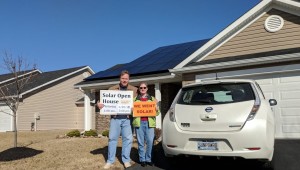Robert Goes Solar -– Falling Waters, West Virginia
From Solar United Neighbors in West Virginia, July 2, 2019
Go solar and join the future! System size: 11.4 kW
Why did you decide to go solar?
My wife and I have owned an electric vehicle since 2015 and we knew we wanted to have enough solar to power the car and the house. Our array provides enough power to offset the annual usage of the all-electric house, two electric vehicles, and all electric lawn equipment. Controlling the source and cost of energy for the home and cars was a big factor along with minimizing CO2 emissions and pollution.
Has anything surprised you about going solar?
I was quite surprised by how quickly the array went up on the roof. The paperwork may have taken a few weeks, but the actual install was fast. I’m very pleased with the look of the final installation.
What electricity savings have you experienced since going solar?
Since the system went onto a new house we are unsure about exact usage, but I am estimating about $2,700 saved in electricity since September 2017. I estimate an additional $1,300 saved in fuel for vehicles over that time. We have also made efficiency improvements to the house, so there are some variables, but we’ve had a $5/month power bill, the minimum charge, since March 2018 and have a 3,500 kWh credit at the moment.
What advice would you give to someone is considering going solar?
First, look at solar not only as an investment in your home, but also the environment. Second, consider what efficiency upgrades you can make to your existing home. Get an energy audit! Lastly, I’d recommend pairing an electric vehicle with your solar system if at all possible. Once you know the convenience of waking up to a full tank every morning and not even noticing the price of gas, you won’t go back. And, EVs are a blast to drive! Go solar and join the future!
TOMORROW …. “West Virginia fails to legalize Power Purchase Agreements”


{ 2 comments… read them below or add one }
Tech Tent – Electric cars in the fast lane – BBC Sounds
From: Rory Cellan-Jones, Technology correspondent, 11/20/20
This week, the UK government announced that sales of new petrol and diesel cars will be banned from 2030 – just one signal among many around the world that a major shift to low-carbon motoring is under way.
In practice, that means millions of people are going to have to be persuaded to choose an electric car – and on this week’s Tech Tent we explore how improvements in battery technology can make that happen.
The last decade has seen major advances in battery-powered motoring, with Elon Musk’s Tesla leading the way in showing that electric cars don’t have to be ugly – and they don’t have to stop every 20 miles to recharge.
But anxiety over the cars’ range, charging availability and initial cost are still issues for potential buyers.
Colin Herron, an automotive engineer who worked for Nissan for many years and is now a consultant on low-carbon vehicle technology, tells Tech Tent there are reasons to be cheerful about future advances in batteries. Lithium-ion batteries are the first target.
“We will be tampering with this battery over the next four or five years, and putting more additives in will get about another 20% boost in performance,” he explains.
But he says the big leap forward will come with solid state batteries, which will appear first in mobile phones and laptops before they progress to cars. They promise to be a safer and lighter option, and researchers believe they can offer much faster charging.
“They’re all targeting 10 to 12 minutes. That’s what they think is the ‘stop time’, the convenient time to check your email for people who are moving on.”
Herron believes, however, that we will all need to change the way we think about motoring in the electric era: using trains for longer journeys, and keeping the car for shorter local trips where stopping to charge will not be necessary.
And he cautions that we also need to realise that describing electric motoring as “zero carbon” may be wide of the mark: “It’s emission-free motoring, but the car has to be built, the battery has to be built, and the electricity does come from somewhere.”
AUDIO BROADCAST —
https://www.bbc.co.uk/sounds/play/w3cszhpn
Frequently Asked Questions (FAQs) – U.S. Energy Information Administration (EIA)
https://www.eia.gov/tools/faqs/faq.php?id=93&t=8
How many alternative fuel and hybrid vehicles are there in the United States?
The U.S. Energy Information Administration (EIA) publishes annual data on the number of alternative fuel vehicles (AFV) in inventory for four types of vehicle fleets: federal government, state governments, transit agencies, and fuel providers.
EIA publishes data on the supply of AFV and gasoline-electric hybrid and diesel-electric hybrid vehicles from two types of suppliers: original equipment manufacturers and aftermarket vehicle converters.
EIA has estimates and projections for stocks of AFV including electric and hybrid-electric vehicles in the United States in the Annual Energy Outlook. See tables:
Table 39. Light-Duty Vehicle Stock by Technology Type
Table 45. Transportation Fleet Car and Truck Stock by Type and Technology
Table 49. Freight Transportation Energy Use
Learn more:
Definitions for AFV and hybrid vehicles
Last updated: May 26, 2020